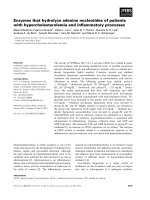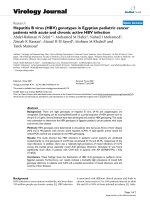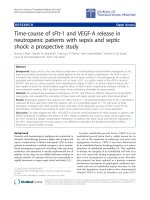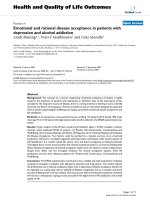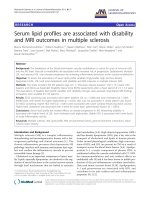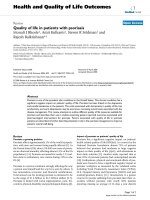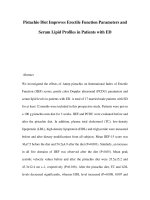Serum lipid abnormalities in patients with psoriasis and the adding effect of simvastatin in the treatment of psoriasis vulgaris
Bạn đang xem bản rút gọn của tài liệu. Xem và tải ngay bản đầy đủ của tài liệu tại đây (713.7 KB, 29 trang )
1
BACKGROUND
Psoriasis is a common immuneimmediated chronic inflammatory
disease, affecting negatively on patients’ quality of life and there is
no specific method to cure it. Recently, many studies have shown the
association between psoriasis and cardiovascular (CV) disease.
Dyslipidaemia plays an important role in atherosclerosis and is a
primary risk factor for CV disease. Many researches have shown the
changes in serum lipid such as increased triglyceride, total
cholesterol, LDLC, VLDLC, and decreased HDLC. The
association between psoriasis and dyslipidaemia remains
controversial. It is the reason why this field needs to be more studied.
Statins, including simvastatin, are dyslipidaemia treatment drugs
which inhibit 3hydroxy33methylglutaryl coenzyme A reductase
resulting in decreased synthesis of cholesterol in the liver. In addition
to their lipid lowering effects, statins have many antiinflammatory
immunomodulator properties which are beneficial in atherosclerosis
and coronary artery disease. Based on psoriasis pathogenesis, we feel
that statins can decrease psoriatic disease activity through their anti
inflammatory immunomodulatory properties.
To our knowledge, in Vietnam, there are no reports with sample
large enough evaluating lipid profile in patients with psoriasis as well
as no clinical trials investigating the effects of statins in the treatment
of psoriasis. Therefore, we conducted the thesis “Serum lipid
abnormalities in patients with psoriasis and the adding effect of
simvastatin in the treatment of psoriasis vularis” with objectives as
following:
1. To evaluate some associated factors and clinical features of
psoriasis in HCMC Hospital of DermatoVenereology.
2. To determine the prevelance of dyslipidaemia and associated
factors in patients with psoriasis.
3. To evaluate the adding effect of simvastatin in the treatment of
psoriasis vulgaris.
NEW CONTRIBUTIONS OF THE THESIS
1. Contributing to data on some associated factors, clinical features
of psoriasis.
2
2. Proving dyslipidaemia status in patients with psoriasis.
3. Proving the adding effects of simvastatin in the treatment of psoriasis
vugaris, providing a new option to treat this disease.
THE THESIS CONTENTS
The thesis includes 113 pages. Background: 2 pages; Conclusions: 2
pages; Recommendations: 1 page; Chapter 1 Review: 37 pages;
Chapter 2Patients and Methods: 10 pages; Chapter 3Results: 27 pages;
Chapter 4Discussion: 34 pages. There are 55 tables, 12 charts, and 3
images, appendix and 153 references with 11 vietnamese and 142
english ones.
CHAPTER 1
REVIEW
1.1. Review of psoriasis
1.1.1. Epidemiology
The prevalence of psoriasis is about 2 3% of general population.
It may begin at any age. There are two age peaks of onset: 20 30
and 50 60. Psoriasis is equally common in males and females.
1.1.2. Pathogenesis
Psoriasis is the interaction of genetics, skin barrier deficiency, and
innate and adaptive immunity disorders. Most studies show have
shown the roles of T cells, dendrite cells, cytokines, and chemokines…
in psoriasis pathogenesis.
1.1.3. Clinical features
1.1.3.1. Skin lesions
Erythematous, scaly, sharply demarcated plaques in different sizes
and shapes are hallmarks of psoriasis. Psoriasis tends to be
symmetric and this feature is useful for definitive diagnosis.
1.1.3.2. Clinical patterns
Psoriasis is classified into two major categories:
Psoriasis vulgaris: plaquetype, guttate, small plaque psoriasis.
Other psoriasis types: pustular, erythrodermic, nail psoriasis and
psoriasis arthritis.
1.1.4.Histopathology: Increased dermal mononuclear infiltrate,
3
increased hyperkeratosis and parakeratosis, and Munro’s
microabscesses
1.1.5. Measures of severity
1.1.5.1.
Body surface area (BSA):
Based on BSA, psoriasis is classified into: mild (< 10%),
moderate (10 30%), and severe (> 30%).
1.1.5.2.
Psoriasis Area and Severity Index (PASI):
PASI ranges from 0 to 72. Higher scores indicate greater psoriasis
severity. Based on PASI, psoriasis is classified into: mild (< 10),
moderate (from 10 to < 20), and severe (≥ 20).
PASI reduction (%) = (PASIBaseline PASIAfterTreatment) x 100%/
PASIBaseline
1.1.5.3.
Investigator’s Global Assessment 2011 (IGA 2011)
The IGA is a simple instrument providing a subjective evaluation
of the overall severity of psoriasis. IGA 2011 (IGA 2011) is usually
used in phase 3 clinical trials, ranging from a 5point scale (0 4):
clear (0), almost clear (1), mild (2), moderate (3), and severe (4).
1.1.6. Diagnosis
The diagnosis of psoriasis is usually based on clinical features. In
those few cases in which clinical history and examination is not
diagnostic, biopsy is indicated to establish the correct diagnosis.
1.1.7.Treatment
1.1.7.1.
Topical treatments:
Corticosteroids, vitamin D analogs, Corticosteroids and vitamin D
analogs combination, Anthralin (Dithranol), Retinoid, and others:
acid salicylic, coal tar, calcineurin inhibitors, alo vera cream…
1.1.7.2. Phototherapy
Phototherapy with BBUVB or NBUVB and photochemotherapy
with UVA plus psoralen (PUVA therapy) are classical treatment options.
1.1.7.3.
Systemic treatments:
Methotrexate, Cyclosporine A, Retinoid, Biologics, others:
Fumarates, Mycophenolate mofetil, calcitriol, 6thioguanine,
Hydroxyurea, dapsone.
1.2. Psoriasis and lipidaemia
1.2.1.Brief review of lipidaemia components
4
Cholesterol is a lipid present in cell membranes and is the
precursor of bile acids and steroid hormones. Cholesterol moves in
the blood as separate particles containing both lipid and protein
(lipoproteins). Three main types of lipoproteins found in the serum
are low density lipoprotein (LDL), high density lipoprotein (HDL)
and very low density lipoprotein (VLDL). LDL has atherosclerotic
property and is the first target of cholesterollowering treatment.
HDL has protective role against atherosclerosis. VLDL has the same
atherosclerotic property as LDL. Triglyceride (TG) is synthesized
through two paths: in the liver and adipose tissue (glycerol
phosphate) and in the intestine (monoglyceride). Many studies show
an association between triglyceride levels and coronary heart disease.
1.2.2. Dyslipidaemia
Definition of dyslipidaemia: the increase in levels of serum
cholesterol, triglyceride or both, or the decrease in level of HDLC,
increase in level of LDLC that accelerate atherosclerotic process.
Serum lipid for diagnosis and classification of dyslipidaemia:
triglyceride, total cholesterol, HDLC, LDLC.
1.2.3. Studies on lipid profile in patients with psoriasis
The present studies have determined serum lipid abnormalities in
patients with psoriasis. Although the association between serum lipid
abnormalities and psoriasis has been reported for decades, it is still
unclear whether serum lipid abnormalities result from or in this
chronic disease. Currently this issue is still being discussed and
researches are still conducted and published.
1.3.
Statins in dermatology
1.3.1. Background
1.3.1.1. Mechanisms
Statins, including simvastatin, are competitive inhibitors of 3
hydroxy33methylglutaryl coenzyme A (HMGCoA) reductase, an
important enzyme in cholesterol synthesis conveting HMGCoA to
mevalonate.
1.3.1.2. Indications
Hypercholesterolemia
Primary prevention of coronary artery disease
Atherosclerosis.
5
1.3.1.3.
Contraindications and use in preganancy
Statins should be avoided in patients with hypersensitivity to any
drug components. Contraindications to statin use include active liver
disease or persistent elevations in liver function tests (transaminases),
heavy alcohol use, and renal insufficiency. Statins are contraindicated
in women who are or may become pregnant, or breast feeding.
1.3.1.4. Adverse effects
Generally, statins are well tolerated and the rate of drug cessation
is low. The statins’ side effects are hepatotoxicity, myositis, and
rhabdomyolysis.
1.3.1.5.
Precautions
Liver function tests should be performed prior to the initiation of
statin therapy and when otherwise clinically indicated.
1.3.2. Statin use in dermatology
In addition to their lipid lowering properties, statins have anti
inflammatory immunomodulator activities that may be beneficial in
several autoimmune skin diseases, dermatitis, graftversushost
disease, vitiligo, cholesterol embolization, lipoma, xanthelasma,
neurofibromatosis, uremic pruritus, HIV, hirsutism, and topical
therapy with statins…
1.3.3. Studies of using statins in psoriasis treatment
In literature, there are several reports of using statins in psoriasis
treatment. Simvastatin alone was used in a study in Russia while
simvastatin plus topical corticosteroid were used in a study in Iran for
treatment of plaque psoriasis. Both studies showed good results but
did not evaluate the changes of serum lipid. However, a study in
Germany did not showed the effectiveness of statins in the treatment
of psoriasis, maybe due to small sample size.
In summary, the effect of statins should be more studied.
CHAPTER 2
SUBJECTS, MATERIALS AND METHODS OF STUDY
2.1. Subjects
Study subjects were patients with psoriasis in HCMC Hospital of
DermatoVenereology from 01/2011 to 12/2014.
6
2.1.1. Diagnostic criteria
Diagnosis was mainly based on clinical examination. In the
untypical cases, definitive diagnosis was based on histology.
2.1.2. Inclusive critetia
2.1.2.1. For objective 1:
Patients with psoriasis in HCMC Hospital of Dermato
Venereology.
2.1.2.2. For objective 2:
Patient group: patients with psoriasis in HCMC Hospital of
DermatoVenereology.
Control group: healthy, age and sexmatched individuals
without psoriasis.
2.1.2.3. For objective 3:
Patients with plaque psoriasis, aged from 18 years old.
2.1.3. Exclusive criteria
For all 3 objectives: Patients with diseases that can cause
secondary hyperlipidaemia, such as hypothyroidism, diabetes
mellitus, nephrotic syndrome, chronic renal insufficiency, obstructive
liver disease, and connective tissue disease, as well as patients on
medications, such as beta blockers, thiazides, corticosteroids,
retinoids, cyclosporin, and lipidlowering agents, in the recent 6
months. Pregnancy and breastfeeding.
For patients in clinical trial (objective 3), additional exclusive
criteria were contraindications of Daivobet® and simvastatin such as
hypersensitivity to any drug components (simvastatin, calcipotriol
and betamethasone dipropionate), active liver disease or persistent
elevations in liver function tests (SGOT, SGPT), history of muscular
diseases, heavy alcohol use, and renal insufficiency.
2.2. Study materials
Simvastatin STADA® (StadaVN) : each tablet contains 20 mg
simvastatin.
Daivobet® (Leo Pharmaceutical Products Ltd A/S Denmark) :
each 30g tube contains calcipotriol 50 µg/g and betamethasone
dipropionate 500 µg/g.
2.3. Methods
2.3.1. Study design and sample size
7
2.3.1.1. For objective 1: a crosssectional, prospective study.
2.3.1.2. For objective 2: a crosssectional, prospective study, n = 128
in each group.
2.3.1.3. For objective 3: a randomized controlled trial, n = 30 in each
group.
2.3.2. Steps of study
2.3.2.1.
Taking history: collecting variables related to
general health condition and psoriasis.
2.3.2.2. Clinical examination:
Body Mass Index (BMI), clinical types, clinical features, Body
Surface Area (BSA), Psoriasis Area Severity Index (PASI),
Investigator’s Global Assessment 2011 (IGA 2011).
2.3.2.3. Laboratory tests:
Blood samples were taken after a 12 h overnight fasting to
determine SGOT, SGPT, total cholesterol, triglyceride (TG), low
density lipoprotein cholesterol (LDLC) and highdensity lipoprotein
cholesterol (HDLC). Dyslipideamia was defined with at least one of
criterium: total cholesterol ≥ 6,20 mm/L, or TG ≥ 2,26 mm/L, or
LDLC ≥ 4,13 mm/L, or HDLC < 1,03 mm/L.
The blood tests were done in Laboratory Department, HCMC
Hospital of DermatoVenereology.
2.3.3. Treatment follow in clinical trial
2.3.3.1. Study groups:
Patients were randomly divided into two equal groups:
Group 1: 30 patients received simvastatin 20 mg twice daily plus
calcipotriol/betamethasone dipropionate ointment (Daivobet®) once
daily for 8 weeks.
Group 2: 30 patients received the same topical product for the
same time period.
Patients in both groups were guided with the same diet.
2.3.3.2. Treatment followup:
The patients were evaluated at baseline and every 4 weeks for 8
weeks by a dermatologist. For efficacy evaluation, we used Psoriasis
Area and Severity Index (PASI), IGA 2011, and serum lipid. Safety
was assessed by patients’ reports of adverse events, clinical
examination, and liver function tests.
8
Simvastatin would be stopped if transaminase levels were 2
times higher than normal ones. Serum creatin kinase would be done
if patients had muscular pain.
2.3.3.3. Treatment duration: 8 weeks.
2.3.3.4. Measure of treatment outcome: PASI, IGA 2011, serum
lipid (before and after treatment, between two groups).
2.3. Data analysis: The statistical analysis was performed using
EpiInfo version 3.5.1.
2.4. Ethical issue: The study contributed to comprehensive
management of psoriasis. The subjects were informed, explained, and
voluntary to join the study. All laboratory tests were free. All
subjects’ information was kept secret.
CHAPTER 3
RESULTS
3.1. Related factors and clinical features of psoriasis
3.1.1. Related factors
3.1.1.1. Age: from 12 to 90 years old, mean age: 41.9 ± 14.7.
3.1.1.2. Sex: male and female had the same rate (50%).
3.1.1.3. BMI: from 13.5 to 31.1, mean: 21.9 ± 3,1, the normal BMI
group had the highest rate (74.2%).
3.1.1.3. Family history of psoriasis:
Nhận xét: most of cases had no
family history of psoriasis (89.1%)
3.1.1.4. Age of onset and duration
of psoriasis:
Age of onset: from 5 to 60 years old, mean age of onset: 34.2 ± 15.7.
Duration of psoriasis: from 2 months to 50 years, mean duration: 7.7.
3.1.1.5. Triggering factors:
Factors
n
Rates
9
Emotional stress
56 43.8%
Koebner phenomenon
30 23.4%
Smoking
22 17.2%
Changes of endocrine and metabolism condition
18 14.1%
Drugs
16 12.5%
Alcohol
13 10.2%
Infection
10
7.8%
Emotional stress was the most common triggering factor (43.8%).
3.1.2. Clinical features
3.1.2.1. Clinical types
Plaque psoriasis was the most common type.
3.1.2.2. Distribution of lesions
Features
n
Frequency (%)
Symmetry
80
62.5%
Scalp involvement
95
74.2%
Nail involvement
60
46.9%
Flexural involvement
4
3.1%
Scalp involvement (74.2%) and symmetry (62.5%) had high
frequencies.
3.1.2.7. The association of PASI and duration of psoriasis
Duration of psoriasis
n
PASI
p
≤ 5 years
52
9.18 ± 7.29
p < 0.05
> 5 years
48
12.92 ± 7.27
PASI was significantly associated with duration of psoriasis.
3.2. Dyslipideamia in patients of psoriasis
3.2.1. Baseline characteristics of two groups
Characteristics
Psoriasis
Control
p
group
group
10
(n = 128)
41.9 ± 14.7
(n = 128)
43.3 ± 12.6
Age (mean ± SD)
p = 0.43
Sex:
+ Male
64 (50%)
64 (50%)
p = 1
+ Female
64 (50%)
64 (50%)
BMI (mean ± SD)
21.9 ± 3.1
21.9 ± 3.2
p = 0.93
Physical activity:
+ Not regularly
99 (77.3%)
93 (72.7%)
p = 0.16
+ Once a week
8 (6.3%)
17 (13.3%)
+ > Once a week
21 (16.4%)
18 (13.1%)
Smoking:
+ Daily
19 (14.8%)
11 (8.6%)
p = 0.37
+ Occasional
8 (6.3%)
8 (6.3%)
+ Previous
14 (10.9%)
11 (8.6%)
+ Never
87 (68%)
98 (76.6%)
Alcohol consumption:
+ > 3 times/week
2 (1.7%)
0 (0%)
p < 0.05
+ 2 3 times/week
3 (2.3%)
2 (1.7%)
+ 2 4 times/month
10 (7.8%)
2 (1.7%)
+ Once/month
23 (18%)
34 (26.6%)
+ Never
90 (70.3%)
90 (70.3%)
Demographic data were similar for patients and control subjects
except for alcohol consumption, where patients with psoriasis more
often drunk than control subjects. There was no difference between
patients and control subjects with regard to age, sex, BMI, physical
activity, smoking.
11
3.2.2. Serum lipid in psoriasis group
3.2.2.1. Frequency of dyslipideamia
Dyslipideamia
n
Frequency
General dyslipideamia
69
53.9%
High total cholesterol
32
25%
High TG
32
25%
High LDLC
19
14.8%
Low HDLC
28
21.9%
Total cholesterol/HDLC > 5
26
20.3%
Normal serum lipid
59
46.1%
Frequency of dyslipideamia was 53,9%, in which high total cholesterol
and high TG had the highest frequency (25%).
3.2.2.3. Association of serum lipid and sex
Serum lipid
Male (n = 64)
Female (n= 64)
p
Total cholesterol
5.25 ± 1.16
5.31 ± 1.21
p = 0.77
TG
2.06 ± 1.27
1.66 ± 1.03
p = 0.053
HDLC
1.20 ± 0.27
1.40 ± 0.50
p < 0.001
LDLC
3.11 ± 0.92
3.20 ± 0.99
p = 0.62
There was no difference between male and female subjects with
regard to levels of total cholesterol, TG, and LDLC. The mean level
of HDLC in male subjects was significantly lower than in female ones.
3.2.2.4. Association of serum lipid and duration of psoriasis
Serum lipid
≤ 5 years (n = 64)
> 5 years (n= 64)
p
Total cholesterol
5.27 ± 1.10
5.29 ± 1.27
p = 0.92
TG
1.81 ± 1.11
1.90 ± 1.23
p = 0.66
HDLC
1.33 ± 0.51
1.26 ± 0.28
p = 0.69
LDLC
3.16 ± 0.84
3.16 ± 1.06
p = 0.99
There was no difference in serum lipid (total cholesterol, TG, HDLC,
and LDLC) between subjects with duration of psoriasis ≤ 5 years and
12
subjects with duration of psoriasis > 5 years.
13
3.2.2.5. Association of serum lipid and clinical types
Plaque
Erythrode
Pustulosis
rma
(n = 9)
(n = 11)
Athritis
Serum
lipid
(n = 100)
Total
cholesterol
5.39 ±
1.12
4.90 ± 1.40 4.91 ± 1.16 4.84 ± 1.50 p = 0.27
TG
1.91 ±
1.25
1.84 ± 0.89 1.61 ± 0.79 1.55 ± 0.79 p = 0.77
HDLC
1.34 ±
0.42
1.19 ± 0.36 1.11 ± 0.21 1.17 ± 0.52 p = 0.25
LDLC
3.21 ±
0.94
2.87 ± 1.06 3.07 ± 1.01 2.96 ± 0.95 p = 0.63
p
(n = 8)
There was no difference in serum lipid (total cholesterol, TG, HDLC,
and LDLC) between clinical types.
3.2.2.6. Association of serum lipid and BSA
Serum lipid
Mild
Moderate
Severe
(n = 29)
(n = 44)
(n = 55)
p
Total
cholesterol
5.12 ± 1.24
5.53 ± 1.17 5.17 ± 1.14
p = 0.22
TG
1.84 ± 1.49
2.00 ± 1.20 1.76 ± 0.94
p = 0.43
HDLC
1.29 ± 0.25
1.40 ± 0.57 1.22 ± 0.31
p = 0.054
LDLC
3.00 ± 1.03
3.29 ± 0.91 3.13 ± 0.95
p = 0.42
There was no difference in serum lipid (total cholesterol, TG, HDLC,
and LDLC) between BSA groups.
3.2.2.7. Association of serum lipid and PASI
Serum lipid
Mild
Moderate
Severe
(n = 58)
(n = 30)
(n = 12)
Total cholesterol 5.33 ± 1.20
5.56 ± 1.10
p
5.20 ± 0.76 p = 0.57
14
TG
1.85 ± 1.28
1.83 ± 1.07
2.38 ± 1.50 p = 0.37
HDLC
1.37 ± 0.51
1.31 ± 0.28
1.23 ± 0.19 p = 0.59
LDLC
3.18 ± 0.99
3.41 ± 0.93
2.89 ± 0.66 p = 0.24
There was no difference in serum lipid (total cholesterol, TG, HDLC,
and LDLC) between PASI groups.
3.2.3. Serum lipid between two groups
3.2.3.1. Frequencies of dyslipideamia between two groups
Dyslipideamia
Psoriasis
group
(n = 128)
High general
dyslipideamia
Control group
(n = 128)
p
69 (53.9%)
28 (21.9%)
p < 0,001
High total cholesterol
32 (25%)
14 (10.9%)
p < 0,01
High TG
32 (25%)
11 (8.6%)
p < 0,001
High LDLC
19 (14.8%)
12 (9.4%)
p = 0,18
Low HDLC
28 (21.9%)
5 (3.9%)
p < 0,001
Total cholesterol/HDLC >5
26 (20.3%)
8 (6.3%)
p < 0,01
Frequencies of high general dyslipideamia, high total cholesterol,
high TG, low HDLC and total cholesterol/HDLC > 5 in psoriasis
group were significantly higher than in control group.
3.2.3.1. Levels of serum lipid between two groups
Psoriasis
group
Control
group
p
Total cholesterol
5.28 ± 1.18
5.05 ± 1.08
p = 0.11
Triglyceride
1.86 ± 1.17
1.43 ± 0.79
p < 0.001
HDLC
1.30 ± 0.41
1.44 ± 0.80
p = 0.08
LDLC
3.16 ± 0.95
3.03 ± 0.89
p = 0.27
Serum lipid
15
Total
cholesterol/HDL
4.24 ± 0.91
3.92 ± 1.50
p < 0.05
Level of TG and total cholesterol/HDL in psoriasis group were
significantly higher than in control group.
16
3.3. The adding effect of simvastatin
3.3.1. Baseline characteristics between two groups
Group 1
Group 2
(n = 30)
(n = 30)
Age
36.00 ± 10.03
39.10 ± 14.55
p = 0.34
Duration of psoriasis
(months)
69.77 ± 65.32
67.60 ± 65.23
p = 0.89
Sex:
+ Male
+ Female
17 (56.7%)
13 (43.3%)
17 (56.7%)
13 (43.3%)
p = 1
Level of serum lipid:
+ Total cholesterol
+ TG
+ HDLC
+ LDLC
5.45 ± 1.21
2.07 ± 2.65
1.33 ± 0.31
3.18 ± 0.70
5.09 ± 1.02
1.75 ± 1.12
1.20 ± 0.27
3.10 ± 0.82
p = 0.22
p = 0.54
p = 0.09
p = 0.68
IGA:
+ IGA = 2
+ IGA = 3
10 (33.3%)
20 (66.7%)
9 (30%)
21 (70%)
p = 0.78
BSA
15.24 ± 8.25
15.12 ± 8.56
p = 0.96
PASI
12.80 ± 5.87
11.86 ± 5.13
p = 0.51
Characteristics
p
There was no difference between two groups with regard to age, age
of onset, duration of psoriasis, sex, IGA, BSA, PASI, and levels of
serum lipid.
3.3.2. PASI response
3.3.2.1.PASI75
Time
Group 1 (n = 30)
Group 2 (n = 30)
p
W4
3 (10%)
1 (3.3%)
p = 0.61
W8
21 (70%)
12 (40%)
p < 0.05
After 4 weeks of treatment, there was no difference in the frequencies of
17
PASI75 between two groups; after 8 weeks of treatment, the frequency
of PASI75 in group 1 was significantly higher than in group 2.
3.3.2.2. PASI improvement
Group 1
Time
Very good
Good
Fair
Moderate
Poor
W4
0 (0%)
3 (10%)
4 (13.3%)
12 (40%)
W8
3 (10%)
18 (60%)
3 (10%)
6 (20%)
11
(36.7%)
0 (0%)
Group 2
Time Very good
Good
Fair
Moderate
Poor
W4
0 (0%)
1 (3.3%) 3 (10%) 8 (26.7%) 18 (60%)
W8
1 (3.3%) 11 (36.7%) 1 (3.3%) 11 (36.7%) 6 (20%)
After 8 weeks of treatment, the frequencies of “very good”, “good”,
“fair” improvement in group 1 were higher than in group 2.
3.3.2.3. PASI changes with treatment
Group 1
Time
Baseline
W4
PASI
12.80 ± 5.87
8.58 ± 5.62
W8
4.17 ± 3.81
p
p < 0.01
p < 0.001
In group 1, PASI at W4 and W8 were significantly decreased
compared to PASI at baseline.
Group 2
Time
Baseline
PASI
11.86 ± 5.13
p
18
W4
9.34 ± 5.01
p = 0.21
W8
6.52 ± 4.89
p < 0.001
In group 2, only PASI at W8 was significantly decreased compared
to PASI at baseline.
3.3.3. IGA
Rate of IGA 0/1 between two groups
Time
W4
W8
Group 1 (n = 30)
2 (6.7%)
17 (56.7%)
Group 2 (n = 30)
1 (3.3%)
9 (30%)
p
p < 0.05
After 8 weeks of treatment, the frequency of IGA 0/1 in group 1 was
significantly higher than in group 2.
3.3.4. Serum lipid with treatment
Group 1
Serum lipid
Baseline
W4
W8
p
Total
cholesterol
5.45 ± 1.21
4.20 ±
0.82
4.18 ±
0.72
p04 < 0.001
p08 < 0.001
p04 = 0.07
p08 < 0.05
P04 = 0.58
1.29 ±
1.35 ±
HDLC
1.33 ± 0.31
0.24
0.24
P08 = 0.78
p04 < 0.001
2.31 ±
2.26 ±
LDLC
3.18 ± 0.70
0.80
0.70
p08 < 0.001
The levels of total cholesterol, LDLC at W4 and W8 were
significantly decreased compared to those at baseline. The level of
triglyceride at W8 decreased significantly compared to that at
baseline.
Triglyceride
2.07 ± 2.00
1.32 ±
0.84
1.26 ±
0.65
Group 2
Serum lipid
Baseline
W4
W8
p
19
p04 = 0.67
p08 = 0.13
p04 = 0.18
1.90 ±
1.84 ±
Triglyceride
1.75 ± 1.12
1.31
1.15
p08 = 0.28
p04 = 0.51
1.23 ±
1.14 ±
HDLC
1.20 ± 0.27
0.31
0.24
p08 = 0.06
p04 = 0.61
3.04 ±
3.22 ±
LDLC
3.10 ± 0.82
0.86
0.81
p08 = 0.57
There was no difference in serum lipid (total cholesterol, TG, HDLC,
and LDLC) between before and after treatment.
3.3.6. Side effects of simvastatin và Daivobet®
Side effects
Group 1 (n = 30)
Group 2 (n = 30)
Mild elevation in
2 (6.7%)
1 (3.3%)
SGOT, SGPT
Irritation
2 (6.7%)
2 (6.7%)
Side effects of both two groups were not remarkable
CHAPTER 4
DISCUSSION
Total
cholesterol
5.09 ± 1.02
5.13 ±
0.94
5.23 ±
1.07
4.1. Related factors and clinical features of psoriasis
4.1.1. Related factors
Mean age of 128 patients with psoriasis was 41.9 ± 14.7, in which
subjects from 31 to 40 years old had the highest rate (28.1%). This result
was the same to those of Truong Le Anh Tuan or Akhyani M but lower
than that in Truong Thi Mong Thuong’s study. In general, mean age of
patients with psoriasis is around 40, main age of social labour force.
Male and female had the same rate (50%), similar to Akhyani M’s
but different from Truong Le Anh Tuan and Truong Thi Mong
Thuong’s study. Our result represents for sex ratio in psoriasis.
According to Fitzpatrick, the sex ratio is 1:1.
Physical activity by doing exercise regularly about 30 minutes
daily helps to maintain healthy and is beneficial for patients with
chronic diseases in general and psoriasis in particular. Our study
20
showed that subjects with irregular physical activity had the highest
rate (77.3%), similar to Truong Thi Mong Thuong’s study (63.5%).
Meanwhile subjects with regular physical activity (> once a week)
just had the rate of 16.4%, lower than that of “doing exercise”
patients in Truong Le Anh Tuan’s study (25%). It is important for
patients with psoriasis to know the role of physical activity.
The mean duration of psoriasis was 7.7 years, from 2 months to
50 years with large variation between patients. The mean age of onset
was 34.2, similar to that in Vo Quang Dinh’s (34.5), Truong Thi
Mong Thuong’s (34.87) và Truong Le Anh Tuan (35.8). Psoriasis can
first appear at any age; however, a bimodal distribution of the age of
onset is characteristic with a peak at 2030 and a peak at 50 60
years old.
Regarding to family history of psoriasis, our study showed that
3.1% of patients had father with psoriasis, 1.6% had mother with
psoriasis, and 6.3% had siblings with psoriasis. Totally, 10.9% of
patients had family history of psoriasis, lower than in Truong Thi
Mong Thuong’s study (14%). Family history varies from 35 to 90%
in patients with psoriasis.
Emotional stress has been shown to trigger or exacerbate
psoriasis. Retrospective data have demonstrated that patients with
psoriasis report more frequent traumatic experiences from early
childhood to adulthood. Emerging evidence shows that abnormal
neuroendocrine responses to stress may contribute to the
pathogenesis of chronic autoimmune diseases, including psoriasis. In
our study, 43.8% patients described stress as being a key
“exacerbator” or trigger of their disease.
There were 23.4% of patients with Koebner phenomenon. This
number might be higher if it had been included with patients who could
not recognize the phenomenon. According to literature, in about 30% of
patients, lesions are reported to have appeared at a site of skin.
Before treatment, it is necessary to take history of previous
treatments and response to each used medicines. In our study,
patients had used many kinds of medicines, from topical to systemic
ones, whereas only 3.9% of patients had no previous treatment. This
result reflected on the diversity of treatments that patients had used.
Topical products were calcipotriol, corticosteroids, salicyclic acid…,
in which calcipotriol and corticosteroids combination was most
21
commonly used with 44.5%. According to majority of authors,
topical calcipotriol and corticosteroids are the first choices for
treatment of mild to moderate psoriasis. In reality, dermatologists
prefer combined products in order to maximize the efficacy and
minimize the side effects.
4.1.2. Clinical features
Our study included all clinical types of psoriasis, in which plaque
psoriasis was the most common (78.1%) and others were psoriatic
erythroderma (8.6%), pustulosis psoriasis (7%), psoriasis athritis
(6.3%). Plaque psoriasis is also the most common in Truong Thi
Mong Thuong’s and Truong Le Anh Tuan’s study.
Stable plaque psoriasis becomes extended or psoriatic
erythroderma because of some triggering factors such as infection,
stress, drugs…In many cases, it is impossiple to identify the risk
factors of psoriatic erythroderma. Our study showed that the rate of
psoriatic erythroderma was not high (8.6%), however patients with
this clinical type need hospitalized to have intensive care and
treatment.
Pustulosis psoriasis is classified into localized and generalized
forms. In our study, pustulosis psoriasis rate was 7% (localized form:
5,5%; generalized forms: 1.5%), lower than in literature (20% of
psoriasis cases).
Psoriasis athritis frequency was 6.3%, in which majority of cases
was mild, non deformed, and few joints damaged. According to
literature, the frequency of psoriasis athritis varies from 5 to 30%.
We accessed the distribution and special sites of lesions (scalp,
nail, and flexural sites). Psoriasis tends to be symmetrical and this
feature is useful for definitive diagnosis. However, one side lesion
may also occur. In our study, the rate of patients with symmetrical
lesions was 62.5%. Symmetry occurs in cases with moderate to
severe or extended psoriasis.
Scalp, nail, and flexural sites are considered special sites of
psoriasis lesions because they remarkably affect on
patients’appearance and are more difficult to treat. Our study showed
that 74.2% of patients had scalp involvement, similar to an
epidemiological survey carried out in the Netherlands with 79% of all
22
patients. The scalp is one of the most common sites at the onset and
throughout the course of psoriasis.
In our study, there were 46.9% of patients with nail involvement.
The clinical manifestations ranged from minimal, for example, in the
form of simple pitting, to extensive changes involving virtually the
entire nail units with destruction and interference with normal functiong.
The frequency of nail psoriasis varies between 10% and 55%. In
patients with psoriatic arthritis, a frequency of about 85% is found.
Our study showed that there were 3.1% of patients having
intertriginous involvement in the armpits, groin, under the breasts…
In literature, involvement of intertriginous areas is only estimated at
2% to 6% of patients with psoriasis. In view of the clinical
presentations, intertriginous psoriasis appears as smooth, mostly very
inflamed skin areas, typically with less or no scaling than seen in
scalp or plaque psoriasis on the body.
Plaque psoriasis has the highest frequency and is studied the most
in pathogenesis, treatment, and measures of severity. Among our 100
patients with plaque psoriasis, mean PASI was 10.97, in which the
mild cases had the most frequency (58%). This frequency is
approximate to that of Truong Le Anh Tuan’s study (65%), but
different from that of Truong Thi Mong Thuong’s study. According
to Truong Thi Mong Thuong, the majority of patients with psoriasis
is severe (40.3%).
Regarding to association between PASI and some factors, our
study showed that PASI was not associated with sex and BMI, but
duration of psoriasis. PASI in patients with duration of psoriasis > 5
years was significantly higher than those with duration of psoriasis ≤
5 years.
4.2. Dyslipidaemia in patients with psoriasis
4.2.1. Serum lipid in patient group
Our study determined the frequency of general dyslipidaemia was
53.9%, in which high total cholesterol and high triglyceride were the
commonest (both 25%). Low HDLC, cholesterol/HDLc > 5, and
high LDLC were 21.9%, 20.3%, 14.8%, respectively.
Dyslipidaemia in patients with psoriasis varies from 6.4% to
50.9%. In a large sample populationbased study, the frequency of
dyslipidaemia in patients with psoriasis was 56.9%, significantly
23
higher than that of control cases (47.3%). In another crosssectional
study in 120 Pakistan patients with psoriasis, the frequency of
dyslipidaemia was 55.8%. These two studies had approximate results
with our study. However, a study in 70 Bosnia & Herzegovina
patients had higher frequency of dyslipidaemia (62.9%). In general,
the comparision of dyslipidaemia frequency among different studies
is relative because the criteria of dyslipidaemia are not the same.
We evaluated the relation between serum lipid levels and some
factors such as sex, duration of psoriasis, clinical types, BSA, and
PASI.
Regarding to sex, HDLC level in male was significantly lower
than in female patients, whereas the rest lipid levels were not
different. In general population, HDLC level in female is usually
higher than in male at every age.
We devided patients into 2 groups: (1) duration of psoriasis ≤ 5
years (64 cases), and (2) duration of psoriasis > 5 years (64 cases).
Serum lipid levels in group 1 seemed “better” than group 2 but the
differences were not significant. In other words, serum lipid levels in
patients with psoriasis were not related to duration of psoriasis. This
result could also be seen in Mallbris’s study in 200 patients with
newly diagnosed psoriasis compared to 285 age and gendermatched
controls. The patient group had higher total cholesterol and serum
LDL levels, and lower HDL levels corresponding to the control
group. It meant that duration of psoriasis had no role in changes of
serum lipid levels. Similarly, Taheri Sarvtin et al also found no
relation between serum lipid levels and duration of psoriasis.
Regarding to clinical types, there was no difference in serum lipid
levels among plaque psoriasis, psoriatic erythroderma, pustulosis
psoriasis, and psoriasis arthritis cases. Beside plaque psoriasis with
the highest frequency, number cases of other types were few. This
result reflected exactly on the real frequencies of clinical types but
number of psoriatic erythroderma, pustulosis psoriasis, and psoriasis
arthritis cases were not large enough to determine the difference in in
serum lipid levels.
Regarding to the severity, we found no relation between serum
lipid levels and BSA and PASI. Mallbris et al had the same findings.
Meanwhile, Javidi et al showed that total cholesterol level was
significantly related to psoriasis severity but LDLC, TG and HDLC
24
were not.
Therefore, our study showed no relation between serum lipid
levels and sex, duration of psoriasis, clinical types, BSA, and PASI.
4.2.2. Comparision of serum lipid levels between two groups
We compared the frequencies of dyslipidaemia as well as serum
lipid levels between two groups. The study showed that the
frequencies of general dyslipidaemia, high total cholesterol, high TG,
low HDLC and total cholesterol/HDLC > 5 were significantly
higher in patients with psoriasis.
Regarding to serum lipid levels, TG level and total
cholesterol/HDLC rate were significantly higher in patients with
psoriasis.
In literature, there are numerous reseaches on serum lipid levels in
patients with psoriasis compared to controls but they present quite
different results. In Vietnam, Truong Le Anh Tuan’s study in 100
patients with psoriasis showed that the frequency of metabolism
syndrome was 38%. However, there was no difference in serum lipid
levels between psoriasis patients and controls. Although this study
was also conducted in HCMC Hospital of DermatoVenereology, the
results were quite different from those of our study. It may be
explained by the difference in study design, inclusion criteria, subject
characteristics.
In general, recent data in 2014 2015 as well as previous reports
long time ago have showed strong association between psoriasis and
abnormalities of fatty acid metabolism.
Why do patients with psoriasis have dyslipideamia? Several
mechanisms for dyslipideamia in psoriasis have been suggested
including chronic inflammatory state, local and systemic metabolism,
genetic factors, unhealthy lifestyle, and uses of psoriasis treatment
medications…
Other comorbid factors that increase the risk of abnormal lipid
metabolism may be found in patients with psoriaisis. These include a
higher body mass index (> 30 kg/m2), a family history of
dyslipideamia, a sedentary life style, a high fat diet, and taking
retinoids or cyclosporine to treat the disease. Antipsoriatic
medications can be also responsible for lipid profile disturbances in
psoriatic patients because of their action on the circulating lipids.
25
Recently it has been shown that infliximab, which is used to treat
patients with psoriatic arthritis, can also increase triglyceride levels in
psoriatic patients.
In our study, several appropriate factors explained partly for
abnormality of lipid metabolism: a sedentary life style (77.3% of
patients had “not regularly physical activity”), alcohol consumption
(significantly higher than controls)…Meanwhile, not many patients
took medications inducing lipidaemia (3,9% of patients used
soriatane).
In summary, our study showed that frequency of dyslipidaemia in
psoriasis group was higher than control one but there is no
association between serum lipd levels and factors such as duration of
psoriasis, sex, clinical types, BSA, and PASI. With emerging
evidence, we recommend all patients with psoriasis be screened for
dyslipideamia regardless of duration of psoriasis, sex, clinical types
as well as severity.
4.3. The adding effect of simvastatin
4.3.1. Clinical effect
In the present study, oral simvastatin plus
calcipotriol/betamethasone dipropionate ointment (Group 1) and
calcipotriol/betamethasone dipropionate ointment (Group 2) were
both effective in the treatment of plaque type psoriasis but the former
treatment worked faster and was more effective than the latter.
After 8 weeks of treatment, clinical indexes including PASI75
and IGA 0/1 in both groups were significantly different from those at
baseline.
Furthermore, PASI improvement in Group 1 was better than in
Group 2. After 8 weeks of treatment, frequencies of “Very good”,
“Good”, “Fair” were 10%, 60%, 10% in Group 1 compared to 3.3%,
36.7%, 3,3% in Group 2, respectively.
In Group 1, the mean PASI score after 4 weeks of treatment was
significantly different from the mean baseline PASI score. This
findings was not seen in Group 2.
Simvastatin enhanced the therapeutic effect of the topical product
with no side effects detected. The efficacy was showed after 4 weeks
of treatment.
